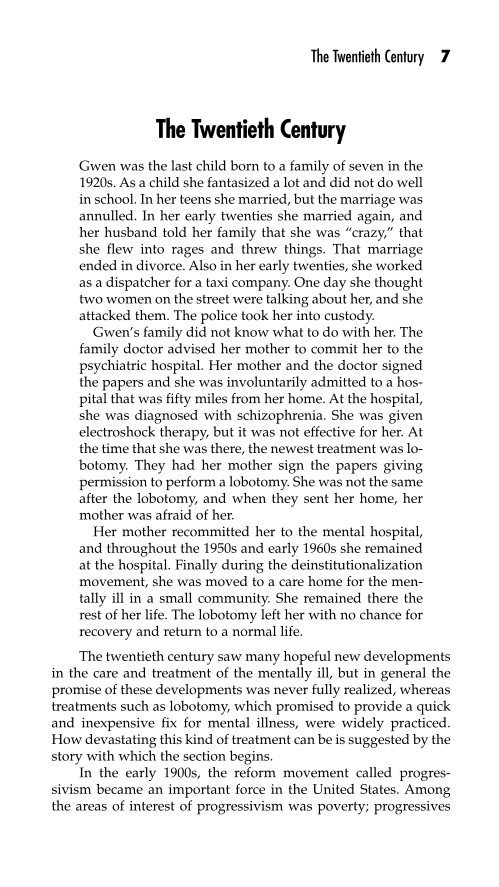The Twentieth Century Gwen was the last child born to a family of seven in the 1920s. As a child she fantasized a lot and did not do well in school. In her teens she married, but the marriage was annulled. In her early twenties she married again, and her husband told her family that she was “crazy,” that she flew into rages and threw things. That marriage ended in divorce. Also in her early twenties, she worked as a dispatcher for a taxi company. One day she thought two women on the street were talking about her, and she attacked them. The police took her into custody. Gwen’s family did not know what to do with her. The family doctor advised her mother to commit her to the psychiatric hospital. Her mother and the doctor signed the papers and she was involuntarily admitted to a hos- pital that was fifty miles from her home. At the hospital, she was diagnosed with schizophrenia. She was given electroshock therapy, but it was not effective for her. At the time that she was there, the newest treatment was lo- botomy. They had her mother sign the papers giving permission to perform a lobotomy. She was not the same after the lobotomy, and when they sent her home, her mother was afraid of her. Her mother recommitted her to the mental hospital, and throughout the 1950s and early 1960s she remained at the hospital. Finally during the deinstitutionalization movement, she was moved to a care home for the men- tally ill in a small community. She remained there the rest of her life. The lobotomy left her with no chance for recovery and return to a normal life. The twentieth century saw many hopeful new developments in the care and treatment of the mentally ill, but in general the promise of these developments was never fully realized, whereas treatments such as lobotomy, which promised to provide a quick and inexpensive fix for mental illness, were widely practiced. How devastating this kind of treatment can be is suggested by the story with which the section begins. In the early 1900s, the reform movement called progres- sivism became an important force in the United States. Among the areas of interest of progressivism was poverty progressives The Twentieth Century 7
Document Details My Account Print multiple pages
Print
You have printed 0 times in the last 24 hours.
Your print count will reset on at .
You may print 0 more time(s) before then.
You may print a maximum of 0 pages at a time.










































































































































































































































































































































